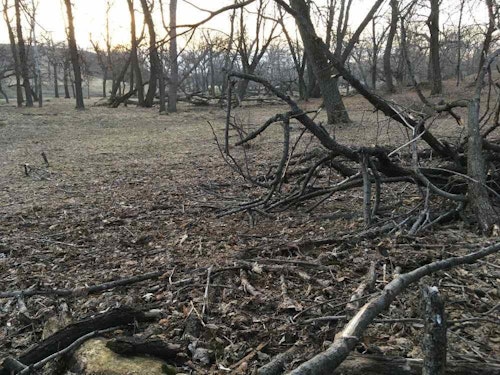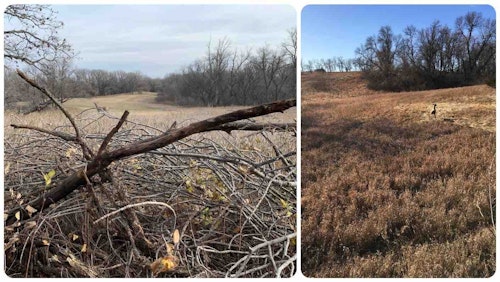
The author’s 160-acre permission property in South Dakota is relatively open, which is why in the past he’s designated the thickest 10-acre spot as an off-limits sanctuary.
If you’re fortunate enough to pursue whitetails on private land where hunter numbers are limited — maybe you have exclusive permission — then you might have one or more areas designated as sanctuaries. The idea makes sense: By avoiding certain areas, you don’t put too much hunting pressure on your land, and whitetails — especially mature bucks — will feel safe. Because they feel safe, they spend the majority of their time on your property, which increases your chances of getting a shot.
On the private lands I bowhunt in South Dakota and Wisconsin, my hunting partners and I stay out of sanctuaries unless we must blood trail a deer. The 240-acre Wisconsin property is one large block of hardwoods with a few swamps and ponds; it’s adjacent to a massive public property. Our Wisconsin sanctuaries don’t have clear borders because the habitat doesn’t really change much; we simply avoid hiking or hunting certain regions in the property’s interior and focus instead on the edges.
The 160-acre South Dakota property sets up much differently. It runs along a half mile of a small river, with hardwoods in the bottom (along the water) and CRP/prairie on the higher ground (top photo). In general, the property is quite open, except for our 10-acre sanctuary, which is a tangled thicket of blowdowns and underbrush. While whitetails have a few areas on the 160 acres where they will bed, their absolute favorite location is the sanctuary.

Because the South Dakota land is home to a good number of mature bucks during late-October through November, I spend my annual week-long “rut vacation” there in early November, as well as a few other 3-day weekends. The Wisconsin property can be decent during this time, too, but it simply doesn’t compare to the SoDak ground.
South Dakota Strategy
My game plan in South Dakota during the rut is to hunt likely travel corridors, hoping to intercept a buck as he’s cruising looking for a doe in heat. When the wind is right, I’ll also hunt afternoons near a half-acre brassica field, which is positioned in the bottom but offers good access from the prairie above.
One place I never hunt, of course, is the 10-acre sanctuary itself. I have a few treestands positioned within sight of its edge, but I’m careful to not walk so close to it as to alert deer bedded in the sanctuary, and I avoid walking around it when the wind will blow my scent into it.

As I stated earlier, the only time we penetrate a sanctuary is to blood trail a deer, which occurred the last time I was in South Dakota. Unfortunately, a buddy hit a 4x4 too far back, and the buck traveled into our sanctuary. As I looked for blood, I couldn’t help but notice the many scrapes within the thick cover, as well as well-worn deer trails traveling throughout it. Standing at the intersection of a heavy north/south trail with an equally heavy east/west trail, with two massive fresh scrapes, I looked south up the steep hill to a massive oak, which was located only 15 yards into the sanctuary — and I had this lightbulb moment:
Not only would that oak be the perfect ambush location to shoot to the trail intersection and scrapes, but the tree’s diameter would break up my silhouette. If I had a tall ladder in that spot, something like an 18-footer with a comfortable seat and large platform, I could sit (and stand occasionally) in the ladder dark to dark during the rut. With a strong and steady south or southwest wind, I could slip into the ladder from the prairie above, having to walk only 15 yards into the sanctuary. If I climbed into the stand at least 30 minutes before shooting light, my chance of bumping deer would be very low. The wind would take my scent away from the sanctuary and out over the prairie to the north.
And here’s the most important consideration: I’d choose to sit in this sanctuary ladder only on those rut days when the temperature would allow me to hunt all day. To avoid spooking deer within the thick sanctuary cover, I wouldn’t be able to leave my stand until the deer had exited the bedding cover to feed on nearby ag fields for the evening. Of course, this would mean packing a lunch and eating only when my movement wouldn’t spook deer. And I’d have to choose the appropriate times to go to the bathroom from the stand, too.

The Reward
Hunting within the sanctuary, even just 15 yards, comes with some risk, but in my opinion, the reward would far outweigh it. During the rut, I know that bucks would be moving within the boundaries of the sanctuary to check on doe/fawn families, and visiting scrapes. Sure, some bucks leave the sanctuary and travel throughout the river-bottom looking for a doe in heat, but the vast majority of them spend most of the daylight hours within security cover. And I’d be in that same cover waiting for them.
As I contemplated this new strategy, and thought about how to put my plan into action for the 2024 deer season, I found this 9-minute YouTube video from professional archery athlete and coach John Dudley of Nock On Archery. He explains how he hunts within an Iowa sanctuary only 2 days per year, during the rut, of course.
Important note: Be sure to watch to the end of the video for an amazing sequence; after Dudley’s monster buck is down, a massive 5x4 shows up on the scene and mauls it!





